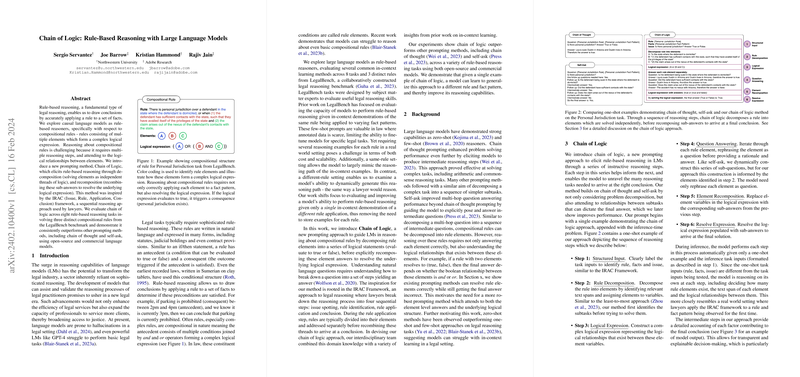Enhancing Rule-Based Reasoning in LLMs with Chain of Logic
Introduction to Chain of Logic
The focus of this article centers on an exploration into the advancements in rule-based reasoning within LLMs (LMs), particularly through the lens of legal reasoning. Rule-based reasoning, especially when dealing with compositional rules, poses significant challenges due to the necessity of complex logical expressions and multiple reasoning steps. This paper introduces "Chain of Logic," a prompting methodology inspired by the IRAC framework, tailored to enhance LMs' ability to navigate the intricacies of such reasoning tasks effectively.
Evaluation: Benchmarks and Results
The evaluation encompassed eight rule-based reasoning tasks using the LegalBench benchmark, focusing on three distinct compositional rules. This methodology leverages a decompose-recompose approach, breaking down rules into manageable components before synthesizing the logical expression formed by these components. The chain of logic method is compared against existing prompting paradigms, such as chain of thought and self-ask, across a variety of LMs, including both open-source and commercial platforms.
Notable findings from this research include:
- Consistent outperformance: Across all tasks, the chain of logic approach consistently surpassed other prompting methodologies in terms of rule-based reasoning performance.
- Generalization capabilities: Models prompted with a single instance of chain of logic effectively generalized this reasoning approach to different rule sets and fact patterns, enhancing their rule-based reasoning capacity.
- Transparency and explainability: The stepwise reasoning path elucidated by chain of logic not only aids in correct conclusion derivation but also ensures that the decision-making process remains transparent and interpretable.
Theoretical and Practical Implications
The theoretical significance of this work lies in its potential to deepen our understanding of how LMs can be more effectively utilized in domains requiring sophisticated reasoning capabilities, such as law. From a practical standpoint, improving LMs' performance on rule-based reasoning tasks could significantly benefit the legal industry by enhancing the efficiency and accuracy of legal services. Moreover, this methodology's emphasis on in-context learning greatly reduces dependency on extensive annotated datasets, which are often scarce in specialized domains like law.
Future Directions in LLM Research
While the chain of logic method marks a significant step forward in leveraging LMs for complex reasoning tasks, several avenues remain open for future research. These include exploring multi-pass reasoning strategies, dynamic reasoning path generation, and the integration of retrieval-augmented generation to access external knowledge sources. Moreover, extending this approach to tackle rules with more complicated consequents, beyond simple true/false outcomes, could further broaden the applicability of LMs in rule-based reasoning.
Conclusion
In sum, the chain of logic approach represents a promising advancement in enhancing rule-based reasoning capabilities of LLMs, particularly within the context of legal reasoning. By introducing a method that systematically deconstructs complex rules into comprehensible elements before synthesizing the overarching logical expression, this work sets the stage for future innovations in generative AI and its application in domains requiring sophisticated reasoning.
